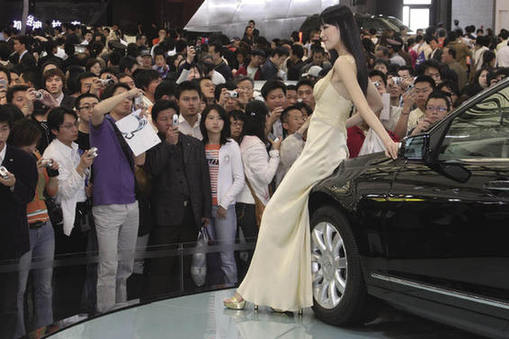|
An Era of Private Cars?
From 1958 to 1981, the First Automobile Works made 1,510 Hongqi-brand cars. In 1995 it developed a model generally known as the minor Hongqi, based on the Audi 100. In 1958 Shanghai Automobile Assembling Factory presented another domestic brand, Shanghai, and produced a total of 77,054 vehicles between 1958 and 1991. Before 1979, only senior officials had access to cars, and private vehicles were not allowed. At that time, the number of cars averaged one per 2,000 people, the lowest worldwide.
The first car that entered wide private use in China was the Fiat 126P imported from Poland. A mini model just 300 cm long and 130 cm wide, it sold for RMB 7,000 in 1986 (the exchange rate at that time was RMB 2.4 to US $1). The Fiat was commonly known as "little P," "big-head shoe," or "small potato," and it became a symbol of wealth in the early reform period. But during the 1990s, with the appearance of other models, the Fiat 126P was phased out. Wenzhou City in Zhejiang Province once had two-thirds of China's Fiat 126Ps, but it now only has two: one in a museum and the other owned by a private car collector.
In the mid-1980s three joint venture auto manufacturers – the Beijing Jeep, Shanghai Volkswagen and Guangzhou Peugeot – were established. In 1987, the central government set a policy of boosting the domestic automobile industry. By the early 1990s three big auto manufacturers – Shanghai Volkswagen, FAW Volkswagen and Dongfeng-Citroen – and three smaller ones – Tianjin Xiali, Beijing Jeep and Guangzhou Peugeot – had taken shape. During this period 70 percent of government purchasing power went into car consumption, a heavy burden on state finance.
In 1994, the Chinese government began to encourage citizens to buy private cars. In the mid and late 1990s, a number of brands priced at around RMB 100,000 became the most popular, including Santana, Jetta, Fukang and Xiali. Richer consumers preferred luxury models like Rolls Royce and Ferrari, despite the high import tariff of 220 percent.
 |
|
China is the second largest auto market after the United States, and car shows attract large numbers of visitors. |
After China joined the WTO in 2001, China's automobile industry grew exponentially, and since 2006 China has been the second largest auto market after the United States. It has also become the third largest auto manufacturer after Japan and the United States. Contrary to predictions when China joined the WTO, domestically made automobiles now make up 95 percent of China's car market. Chinese brands such as Jeely, Brilliance, Chery, Saic and Great Wall also occupy certain market shares. According to the National Statistical Bureau, the total number of autos in 2008 was 64.67 million units, which included 19.47 million private cars.
Automobiles registered in China have increased 35-fold since 1978, when China implemented the policy of reform and opening-up. The number of automobiles in Beijing alone is now increasing by 1,000 a day. Despite this huge growth, Dong Yang, executive vice president of the China Automobile Industry Association, says that China's overall level of car ownership is not high, averaging less than 50 per 1,000 people. The global average is 120 per 1,000 people, and in the United States the figure is 750 per 1,000 people. There is still a lot of room for growth in China's market.
However, due to road saturation, the average speed of motor vehicles in large cities has slowed from 30-40 km/h in the 1980s to less than 20 km/h at present. According to Qiu Baoxing, vice minister of Housing and Urban-Rural Development, in Beijing's trunk roads the average car speed has dropped by 50 percent over the past decade. Of the 183 main intersections in the downtown area, 60 percent are seriously congested. According to calculations of the Institute of Quantitative & Technical Economics, Chinese Academy of Social Sciences, economic losses caused by traffic congestion in Beijing in 2007 amounted to RMB 14.6 billion. The figure for the whole country was RMB 170 billion.
|
